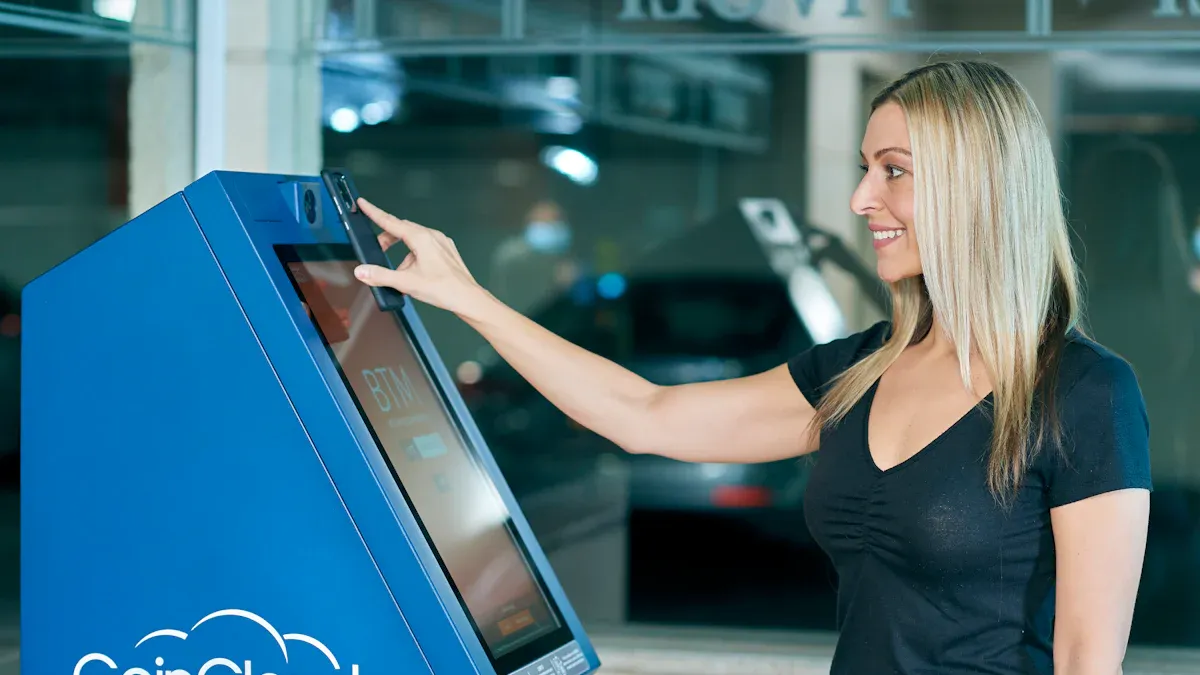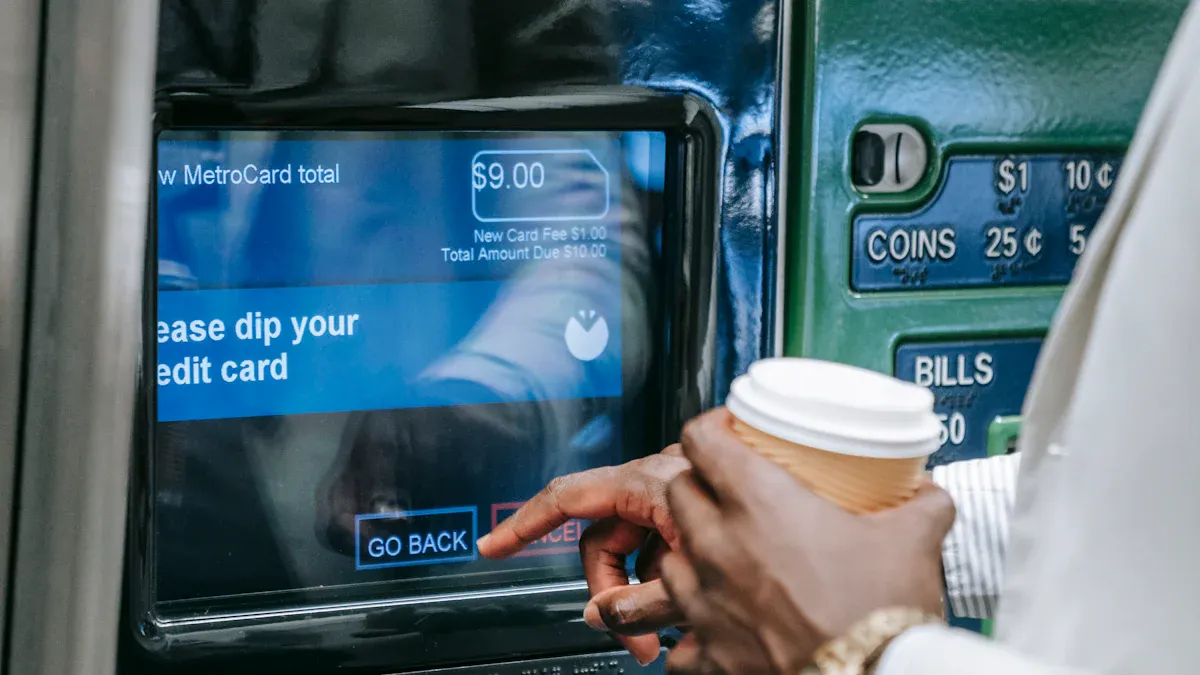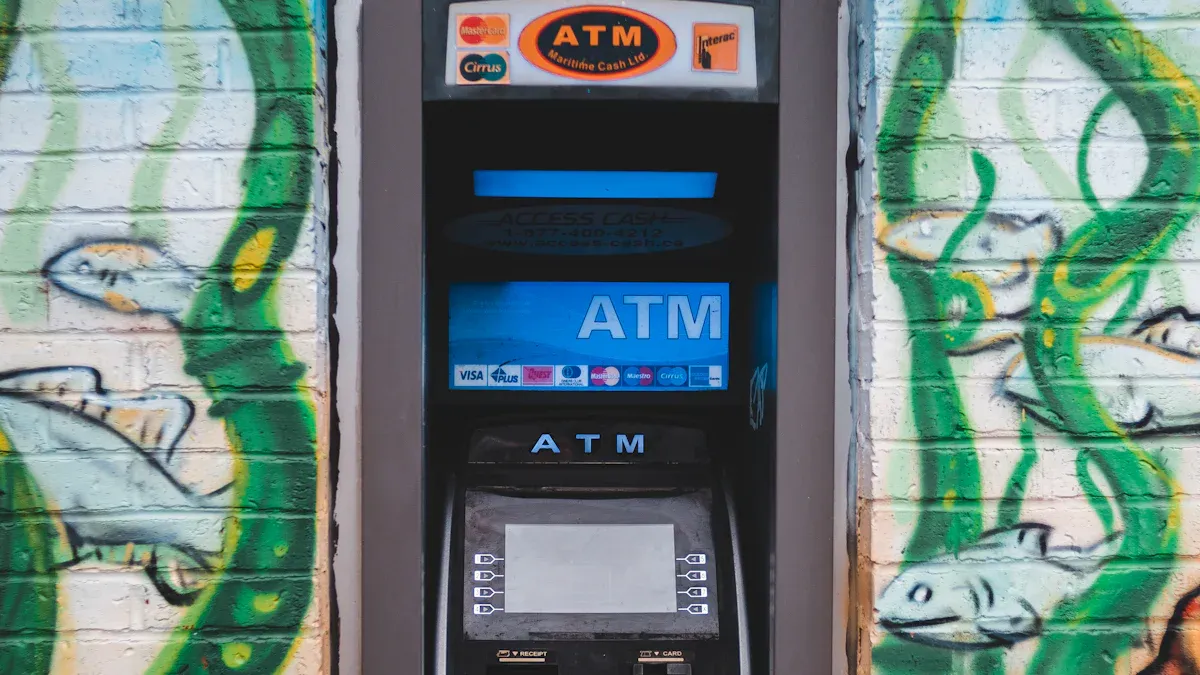- EasyCard
- Trade
- Help
- Announcement
- Academy
- SWIFT Code
- Iban Number
- Referral
- Customer Service
- Blog
- Creator
How to Use Cardless ATMs and Where to Find Them in 2025

Image Source: pexels
You can now use ATMs without a physical card in 2025. Cardless atms let you withdraw cash or check your balance with your phone or smart device. These cardless atms help you avoid lost or stolen cards. Many people choose them because they offer a fast and secure way to access money. You only need your mobile banking app or digital wallet to get started.
Key Takeaways
- Cardless ATMs let you withdraw cash using your phone without a physical card, making transactions faster and safer.
- You need to set up your mobile wallet or banking app before using a cardless ATM to connect your account to your phone.
- Cardless ATMs use NFC or QR codes for contactless transactions, reducing the risk of card theft and skimming.
- Strong security features like biometrics, one-time codes, and tokenization protect your money during cardless withdrawals.
- You can find cardless ATMs using your bank’s app, online maps, or customer service, but check if your bank supports this feature first.
Cardless ATMs Overview
What Are Cardless ATMs
You can use cardless atms to get cash without a physical card. These machines let you access your money by using your smartphone or a mobile wallet. You do not need to insert or swipe a card. Instead, you use your bank’s app or another cardless option to start the process. This makes it easier to get cash if you forget your card or want to avoid carrying one. Cardless atms help protect you from card skimming because you never insert a card. You get more convenience and better security compared to traditional machines.
Tip: Cardless atms often work with your bank’s mobile app, so make sure you have it installed and set up before you visit the ATM.
Main Technologies (NFC, QR Codes)
Cardless atms use advanced technology to make transactions simple and safe. The two main ways you can use these machines are through Near Field Communication (NFC) and QR codes. With NFC, you tap your phone or mobile wallet near the ATM’s reader. The machine reads your information and starts the transaction. If you use a QR code, you scan a code on the ATM screen with your phone. Your app connects to the ATM and lets you finish your transaction. Both methods use contactless payments, which means you do not need to touch the machine much. This keeps your information safe and speeds up the process.
Security Features
You get strong security when you use cardless atms. These machines use several layers of protection to keep your money safe:
- No card insertion means no risk of card skimming.
- Each transaction uses a unique QR code or a one-time code that expires quickly.
- Tokenization hides your real card number by using a random code during the transaction.
- Your mobile wallet uses passcodes or biometrics, such as fingerprint or facial recognition, to confirm your identity.
- Some cardless atms ask you to enter your PIN or use biometrics at the machine for extra security.
| Innovation Area | Description |
|---|---|
| Biometric Authentication | Use of fingerprint, facial recognition, iris scanning, and voice recognition for security. |
| Mobile App-Based Authentication | Mobile banking apps create one-time passwords or tokens for each transaction. |
| Contactless Payment Technologies | NFC and QR code scanning allow secure cardless transactions. |
| Blockchain Technology | Some banks use blockchain to improve transaction security and integrity. |
| Enhanced Security Protocols | Multi-factor authentication, real-time fraud detection, and encryption protect your account. |
| Fraud Risk Mitigation | Cardless atms reduce risks like card theft, hacking, and phishing attacks. |
You can trust cardless atms to keep your money safe while making contactless payments fast and easy.
How to Use a Cardless ATM

Image Source: pexels
App and Wallet Setup
To start using cardless ATMs, you need to set up your mobile wallet or banking provider’s app. This step is important because it connects your bank account to your phone. Here is how to set up your mobile wallet for cardless cash withdrawal:
- Open your mobile wallet app, such as Apple Wallet, Google Pay, or Samsung Pay.
- Tap the option to add a card.
- Enter or scan your debit or credit card information.
- Complete the card verification process for security.
- Make sure your banking provider’s app is updated and linked to your account.
Tip: Always check that your mobile app supports cardless transactions before you visit the ATM.
After you finish these steps, your phone is ready for contactless payments and cardless cash withdrawals at supported ATMs.
Cardless Cash Withdrawal Steps
You can withdraw money from cardless ATMs using two main methods: NFC and QR codes. Both methods make cardless cash withdrawal fast and secure.
- Open your mobile wallet or banking provider’s app.
- Select your virtual debit card.
- Tap your phone on the ATM’s contactless reader.
- Enter your ATM PIN when prompted.
- Choose the amount you want to withdraw and complete the transaction.
QR Code Method:
- At the ATM, select the cardless cash withdrawal option.
- The ATM displays a unique QR code on the screen.
- Open your mobile app and scan the QR code.
- Enter the amount you want to withdraw in the app.
- Confirm the transaction and wait for the ATM to dispense your cash.
Many people prefer the QR code method because it lets you control the transaction from your phone. You do not need to touch the ATM much, which keeps your information safe and makes the process feel smooth.
Note: Some ATMs may ask you to generate a one-time code in your mobile app. Enter this code at the ATM to start your cardless cash withdrawal.
Authentication and Completion
Security is a key part of how to use a cardless ATM. You must prove your identity before you can withdraw money. Here are the typical authentication steps:
- Log in to your mobile app and select the cardless ATM option.
- Choose the card you want to use and enable it if needed.
- Generate a one-time code or scan the QR code at the ATM.
- Enter your ATM PIN or use biometrics, such as fingerprint or facial recognition, to confirm your identity.
- Complete your cardless cash withdrawal and collect your money.
After you finish your transaction, you can choose how you want to get your receipt. Some cardless ATMs offer digital receipts sent by email or text message. Others let you print a paper receipt if you prefer. This gives you proof of your cardless cash withdrawals and helps you keep track of your spending.
Tip: Always check your transaction history in your mobile app after you withdraw money to make sure everything is correct.
Learning how to use a cardless ATM gives you more control over your money. You can enjoy the benefits of contactless payments, strong security, and easy access to cash without carrying a physical card.
Pros and Cons
Security and Convenience
You gain strong security and easy access when you use cardless ATMs. These machines use mobile apps, QR codes, and biometric checks to keep your money safe. You do not need to carry a physical card, which lowers the risk of card skimming and theft. Cardless ATMs let you start a withdrawal on your phone and finish it at the machine. This process saves time and helps you avoid touching the ATM too much. Many people like how these ATMs work with mobile banking apps and digital wallets. You can use features you already know, which makes the experience smooth and simple.
Cardless ATMs also use advanced technology, such as AI and machine learning, to spot fraud and keep the machines running well. You get faster withdrawals and less worry about losing your card. Tech-savvy users enjoy the seamless link between their phone and the ATM. You can even prepare your transaction before you reach the machine, which speeds up the process.
Note: Cardless ATMs appeal to users who want both security and convenience in their daily banking.
Limitations
You may face some limits when you use cardless ATMs. Here are common challenges and restrictions:
- Withdrawal limits depend on your bank and account type. Always check your bank’s rules for daily cash limits.
- Most cardless ATMs only work with machines owned by your bank. You cannot use every ATM for cardless withdrawals.
- Not all banks offer cardless ATM services. You may need to check if your bank supports this feature.
- If the ATM network goes down, you cannot complete a cardless withdrawal.
- Some banks let you share access for others to pick up cash, but this depends on the bank’s app and policies.
- If someone gets your login details, they could try to withdraw money without your permission.
You might also find some practical issues:
- Cardless ATM transactions sometimes take longer than using a card.
- Different ATM systems can confuse you, especially if you use more than one bank app.
- Scanning QR codes may be hard if your phone camera is not good.
- First-time users often feel unsure about the steps and need better guidance.
Tip: Always review your bank’s instructions and practice using the app before your first cardless ATM visit.
Cardless ATM Locations

Image Source: unsplash
Finding Cardless ATMs
You can find cardless ATM locations in several ways. Many banks include an ATM locator feature in their banking provider’s app. This tool often lets you filter for cardless or contactless ATM options. You can also use Google Maps by searching for terms like “cardless ATMs” or “ATMs near me.” Some ATM locator tools on bank websites or networks help you find machines that may support cardless withdrawals. If you need more help, you can call your bank’s customer support for guidance.
- Open your mobile app and look for the ATM locator feature.
- Use filters to find cardless or contactless ATM options.
- Search online maps for “cardless ATMs” in your area.
- Contact your bank’s customer service for up-to-date information.
Note: Not all ATM locator tools show which machines support cardless withdrawals. Some only list addresses and hours, so always check with your bank before you go.
Cardless ATM technology is growing worldwide. In North America, you see high adoption rates because of strong digital banking systems. Europe and Asia Pacific also show fast growth, with many banks adding new features. The table below shows how different regions use cardless ATMs:
| Region | Adoption Status & Drivers | Key Countries/Markets |
|---|---|---|
| North America | High digital banking use, strong infrastructure | US, Canada |
| Europe | Growth from regulations and mature banking | UK, Germany, France |
| Asia Pacific | Fastest growth, high mobile use | China, India, Japan |
| Latin America | Expanding, more smartphone users | Brazil, Mexico |
| Middle East & Africa | Growing, government digital projects | UAE, Saudi Arabia, select African nations |
Symbols and App Locators
When you visit an ATM, look for special symbols that show cardless or contactless ATM support. The most common is the Contactless Symbol, which looks like a sideways WiFi icon. This symbol tells you that you can tap your phone or card to start a transaction. Some machines also display a QR code on the screen for you to scan with your phone.
- Look for the Contactless Symbol on the ATM.
- Check for a QR code option on the ATM screen.
- Use your mobile app’s ATM locator to find machines with these features.
Tip: Always check your bank’s website or app for the latest updates on cardless ATM locations and supported features.
Cardless ATMs give you a fast and secure way to access cash. You can use your phone and mobile banking app to withdraw money without a physical card. This reduces risks like card loss and card skimming. To use a cardless ATM safely, follow these steps:
- Log in to your bank’s app and request a withdrawal.
- Scan the ATM’s QR code or use NFC.
- Confirm your identity with a PIN or biometrics.
Check your bank’s app or website for the latest cardless ATM locations and features. Banking technology keeps improving, making your experience safer and more convenient every year.
FAQ
Can you use a cardless ATM if your phone battery dies?
No, you cannot use a cardless ATM if your phone battery dies. You need your phone to access your banking app or digital wallet. Always charge your phone before you visit the ATM.
Are there extra fees for cardless ATM withdrawals?
Most banks do not charge extra fees for cardless withdrawals. You may still pay standard ATM fees. Always check your bank’s fee schedule. For example, some Hong Kong banks may charge $2.50 USD per transaction. Check current exchange rates.
What should you do if a cardless ATM does not work?
- Try restarting your banking app.
- Check your internet connection.
- Make sure the ATM supports cardless withdrawals. If problems continue, contact your bank’s customer service for help.
Is it safe to use cardless ATMs in other countries?
Yes, you can use cardless ATMs in many countries. Always use machines from trusted banks, such as major Hong Kong banks. Use your bank’s app to find secure locations.
Tip: Avoid using public Wi-Fi when making cardless withdrawals.
This guide shows you that cardless ATMs offer a glimpse into the future of banking—secure, fast, and mobile. But while you’re enjoying the convenience of cardless cash withdrawals, consider the next step in financial freedom: a truly borderless banking platform. Cardless ATMs may free you from your physical card, but they are still limited to a single currency and specific locations. In a truly digital world, you should be able to manage your money, exchange currencies, and send payments internationally with the same ease. This is where BiyaPay offers a modern, transparent solution for all your global financial needs. Our platform provides real-time exchange rate queries and conversions for a wide range of fiat and digital currencies, with remittance fees as low as 0.5%.
With BiyaPay, you can seamlessly send and receive money across borders with the speed and security you expect. Our fast registration and support for same-day delivery to most countries and regions worldwide help you avoid the delays and high costs of traditional banking. Whether you’re a frequent traveler, an international business owner, or someone managing a global portfolio, our platform is designed to make your cross-border finances simple and efficient. Don’t let confusing fees and rigid systems hold you back. Open a secure account with BiyaPay in minutes and take control of your global finances. Register now to streamline your international transactions.
*This article is provided for general information purposes and does not constitute legal, tax or other professional advice from BiyaPay or its subsidiaries and its affiliates, and it is not intended as a substitute for obtaining advice from a financial advisor or any other professional.
We make no representations, warranties or warranties, express or implied, as to the accuracy, completeness or timeliness of the contents of this publication.




Contact Us
Company and Team
BiyaPay Products
Customer Services
is a broker-dealer registered with the U.S. Securities and Exchange Commission (SEC) (No.: 802-127417), member of the Financial Industry Regulatory Authority (FINRA) (CRD: 325027), member of the Securities Investor Protection Corporation (SIPC), and regulated by FINRA and SEC.
registered with the US Financial Crimes Enforcement Network (FinCEN), as a Money Services Business (MSB), registration number: 31000218637349, and regulated by FinCEN.
registered as Financial Service Provider (FSP number: FSP1007221) in New Zealand, and is a member of the Financial Dispute Resolution Scheme, a New Zealand independent dispute resolution service provider.



















